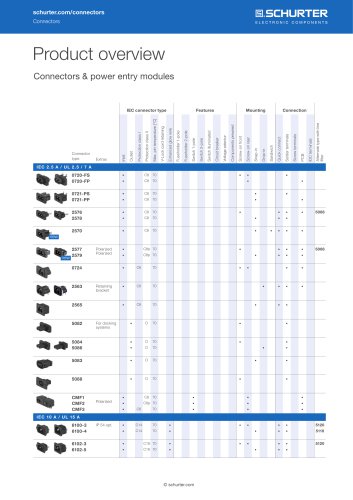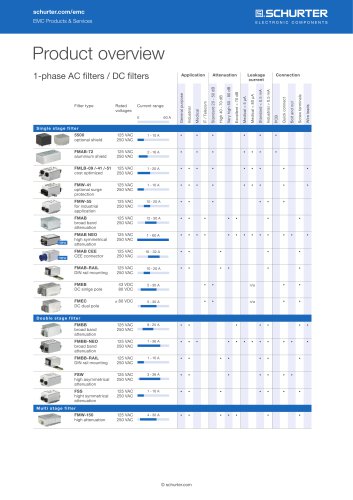 Website:
SCHURTER
Website:
SCHURTER
Group: SCHURTER
Catalog excerpts

White Paper Selecting rated currents for CBE schurter.com/downloads Thermal Circuit Breakers for Equipment Considering the variables that influence the selection of rated current Thermal circuit breakers for equipment (CBE) are particularly suitable for protection of motors and transformers against current overload. The circuit breaker trips when the internal bimetal is deflected. This deflection is caused by current flow that heats the bimetal, resulting in a thermal inertia of the bimetal. It is this thermal inertia that establishes the time-current characteristic of a thermal circuit breaker. - Load current characteristics - Frequency of overload - Switching frequency and the bimetal strip in the circuit breaker cool off again. The CBE should only trip when the machine is exposed to a sustained overload or a motor is even blocked. 7.0 increase temperature increase rigid connection One of the advantages of using a thermal circuit breaker for equipment, over a fuse for instance, is that the circuit breaker is not as sensitive to the inrush currents associated with the start-up of motors and transformers. This means that it is not only the rated current of the load that determines the selection of a circuit breaker, but other parameters such as inrush current, overload capacity, operating duty, or ambient temperature that must also be taken into consideration. Many special types of motors can withstand short periods of overload. In these cases, the rated current of the circuit breaker can be selected with a wider tolerance to prevent the circuit breaker from tripping unnecessarily. The motor's specifications and/or the overload capacity of the protected load must be taken into account as well; these factors being strongly dependent on the equipment's operating mode. In many applications the equipment's operating mode and therefore the load current, which acts on the bimetal strip, is not the same. The heat generated by the load and thus the deflection of the bimetal (Fig. 1) in the circuit breaker depends to a large degree on the following three points: Below is a review of common applications for a thermal circuit breaker, with considerations to selecting the right breaker for each system. Circular Saw Application Let's consider a circular saw application. When turning on the power, the motor initially revs up to its idle state. The saw draws a high load current for a short period of time during this start-up period. This generates a great deal of heat on the bimetal strip. However, because of the wider tolerance of the specified current rating, the circuit breaker does not trip. The saw eventually reaches its idle state, and the bimetal strip cools down. This is because the load amounts to only a few percentages of the rated load. When the equipment is being used, the load related operating current increases. The increase varies depending on factors such as the type of wood, material thickness and the speed at which the wood is being fed to the circular saw blade. In manually operated machines, some of these factors are not consistent and may vary during operation. After a few seconds of operation, the load current decreases again back to a few percent of the rated current and the machine returns to its idle state. During this period, both the motor Circuit Breakers for Equipment Automatic Motor Feeder Applications In applications where the motor is frequently turned on, the rated current specification of the circuit breaker is critical due to the increased power consumption and the short intervals of down time for the system. For example. an automatic motor feeder application (Fig. 3), where the conveyor motor is operated every 10 seconds for a period of 6 seconds and only allows the bimetal 4 seconds to cool down. With these frequent start up currents, the bimetal, and the motor are increasingly heated, which will finally lead to the tripping of the power switch. The motor would be better served if it was operated less often and for a longer time, ultimately leading to longer breaks. In such an application it is therefore necessary to also monitor the frequency of insertions in addition to the overload. 7.0 6.0 Fig. 1: Operating principle of a bimetallic strip
Open the catalog to page 1
Selecting rated currents for CBE White Paper schurter.com/downloads www.schurter.com/downloads Fan Applications It is a great deal simpler to determine the bimetal rated current at a constant load. As an example, the ventilator fan (Fig. 4) works for hours at a constant load and thus provides a constant current. However, with an application such as the ventilator fan, the in-rush current should also be taken into consideration to ensure it does not lead to nuisance tripping of the breaker. Garden Shredder Applications In all cases it is important to consider how well and how safe you want...
Open the catalog to page 2All SCHURTER catalogs and technical brochures
-
FMAD NEO
6 Pages
-
SUSTAINABILITY REPORT 2022
37 Pages
-
THS
5 Pages
-
TTS
4 Pages
-
Product News
4 Pages
-
FMAB NEO
12 Pages
-
FPG1
4 Pages
-
FMAB HV
6 Pages
-
UMT-W
4 Pages
-
OGN
3 Pages
-
0712
3 Pages
-
CPS
7 Pages
-
DG12
10 Pages
-
4751
4 Pages
-
FMAD CP
4 Pages
-
4783
4 Pages
-
EF11
8 Pages
-
PFRY
4 Pages
-
PFRA
6 Pages
-
PFMF
4 Pages
-
PFHT
3 Pages
-
PFDF
3 Pages
-
Company Profile
20 Pages
-
Voltage Selector
1 Pages
-
Resettable Fuses
1 Pages
-
6051.2067
3 Pages
-
6051.2068
3 Pages
-
Suppression Chokes DKIH-1
6 Pages
-
4797-5
4 Pages
-
6051.2063
3 Pages
-
6051.2061
3 Pages
-
6051.2015
3 Pages
-
3-108-993
2 Pages
-
3-100-361
3 Pages
-
GP21
3 Pages
-
AURORA Complete Solutions
2 Pages
-
FMER SOL
10 Pages
-
CMF2, CMF5
3 Pages
-
CDS1
5 Pages
-
DKIH-3
6 Pages
-
4710-5
5 Pages
-
Touchkit
3 Pages
-
USN 1206
3 Pages
-
FPBB RAIL
7 Pages
-
DD14
8 Pages
-
VAC19KS
3 Pages
-
UMK 250
4 Pages
-
TA35 Rocker 1Pole
6 Pages
-
4761
3 Pages
-
4732
4 Pages
-
FUS
3 Pages
-
DKIH
6 Pages
-
FSO
2 Pages
-
CSO
3 Pages
-
CMF1, CMF4
3 Pages
-
FMAC NEO
5 Pages
-
MSM DP 30
8 Pages
-
PSE AE 16
3 Pages
-
MSM LA CS 22
7 Pages
-
MSM LA CS 19
6 Pages
-
PSE AE 30
5 Pages
-
PSE EX 16
5 Pages
-
PSE EX 19
5 Pages
-
PSE NO 19
6 Pages
-
PSE NO 16
6 Pages
-
PSE EX 22
5 Pages
-
PSE NO 27
6 Pages
-
PSE NO 24
6 Pages
-
PSE NO 22
8 Pages
-
PSE IV 16
6 Pages
-
PSE HI 22
6 Pages
-
PSE NO 30
7 Pages
-
PSE M22 IV
7 Pages
-
MCS ES 18
3 Pages
-
MCS ES 22
3 Pages
-
6051.2094
3 Pages
-
6051.2093
3 Pages
-
6051.2078
3 Pages
-
6051.2077
3 Pages
-
6051.2070
3 Pages
-
6051.2072
3 Pages
-
6051.2071
3 Pages
-
6051.2037
2 Pages
-
6051.2030
3 Pages
-
6051.2032
3 Pages
-
6051.2031
3 Pages
-
6051.2027
3 Pages
-
3-107-570
2 Pages
-
3-107-569
2 Pages
-
VAC13KS
4 Pages
-
DD21
5 Pages
-
DD11
5 Pages
-
DF11
6 Pages
-
DG11
7 Pages
-
typ_6051.2016
3 Pages
-
typ_6051.2008
3 Pages
-
typ_6051.2009
3 Pages
-
typ_6051.2001
4 Pages
-
typ_6051.2007
3 Pages
-
typ_6051.2003
3 Pages
-
typ_6051.2004
3 Pages
-
typ_4762
3 Pages
-
typ_3-101-514
3 Pages
-
typ_3-101-501
3 Pages
-
typ_3-100-528
3 Pages
-
typ_3-100-734
3 Pages
-
typ_3-100-526
3 Pages
-
typ_3-100-523
3 Pages
-
typ_3-100-524
3 Pages
-
typ_3-100-527
3 Pages
-
typ_3-100-522
3 Pages
-
typ_3-100-356
3 Pages
-
typ_3-100-355
3 Pages
-
typ_3-100-354
3 Pages
-
Application Note Surge
2 Pages
-
White Paper IP Protection
2 Pages
-
SWA2
2 Pages
-
PB 1021
2 Pages
-
TM12-111
6 Pages
-
PTS
4 Pages
-
Piezo Keypads
4 Pages
-
PB 1011
2 Pages
-
FMAD CEE
3 Pages
-
White Paper Data Center
4 Pages
-
White Paper SPICE library
4 Pages
-
White Paper Cord retention
4 Pages
-
SCHURTER and ESA cooperation
2 Pages
-
Efficient EMC Solutions
8 Pages
Archived catalogs
-
Product News
4 Pages
-
SCHURTER Company Profile
10 Pages
-
PFDF
3 Pages
-
PFHT
3 Pages
-
PFUF
3 Pages
-
SCHURTER Renewable Energies
6 Pages
-
SCHURTER Product News
4 Pages
-
DKFP
5 Pages
-
FMAD RAIL
3 Pages
-
FMAC RAIL
3 Pages
-
FMBD NEO
6 Pages
-
FMAC SINE DCL
4 Pages
-
FMAC SINE
4 Pages
-
FMAB RAIL
3 Pages
-
FMBB NEO
11 Pages
-
FMBB RAIL
3 Pages
-
5120
10 Pages
-
SMD-FTT
1 Pages
-
OMZ 125
1 Pages
-
4840.2200
2 Pages
-
6051.5003
2 Pages
-
6000.0224
2 Pages
-
6051.2030
2 Pages
-
6051.2003
2 Pages
-
FLBB
2 Pages
-
4741
2 Pages
-
P685
2 Pages
-
KE
4 Pages
-
GSF2
4 Pages
-
GSF1
5 Pages
-
Felcom 64
4 Pages
-
6135
5 Pages
-
KG-Bowdencable
4 Pages
-
KD-Bowdencable
4 Pages
-
DC21
3 Pages
-
1074
4 Pages
-
DC11
5 Pages
-
CMF3, CMF6
2 Pages
-
PFNF
3 Pages
-
ESO 10.3x38
1 Pages
-
SHT 6.3x32
1 Pages
-
Product Overview Switches
2 Pages
-
KEB2
1 Pages
-
New product: 6610
3 Pages
-
New product: UMZ 250
3 Pages
-
New product: CSO
2 Pages
-
New product: UST 1206
2 Pages
-
New product: UMF 250
3 Pages
-
New product: UMT-H
3 Pages
-
TA35 Rocker 2Pol
8 Pages
-
SCHURTER range at a glance
236 Pages
-
ASO / FSO
8 Pages
-
Flyer UMT 250 / UMZ 250
8 Pages
-
SCHURTER - Flyer MSM CS
2 Pages
-
Varistors
40 Pages
-
Flyer MGA-S
6 Pages




























































































































































































































































